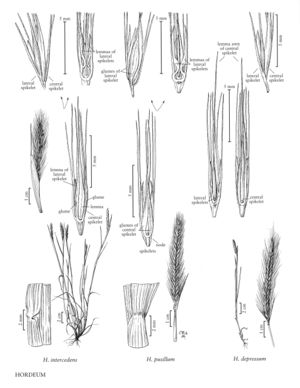Hordeum depressum
Plants annual; loosely tufted. Culms 10-55 cm, erect; nodes glabrous. Basal sheaths pubescent; ligules 0.3-0.8 mm; auricles absent; blades to 7.5 (13.5) cm long, to 4.5 mm wide, sparsely to densely pubescent on both sides. Spikes 2.2-7 cm long, 4-8 mm wide, often partially enclosed at maturity, pale green or with a reddish tinge to the glumes and awns. Glumes straight, ascending to slightly divergent at maturity. Central spikelets: glumes 5.5-20.5 mm long, to 0.5 mm wide, setaceous to slightly flattened near the base; lemmas 5-9 mm, glabrous, awned, awns 3-12 mm; anthers 0.5-1.5 mm. Lateral spikelets sterile or staminate, occasionally bisexual; glumes 5-20 mm; lower glumes slightly flattened near the base; upper glumes setaceous throughout; lemmas 1.8-8.5 mm, unawned or awned, awns to 1 mm. 2n = 28.
Distribution
Wash., B.C., Calif., Idaho, Oreg., S.C.
Discussion
Hordeum depressum grows in vernal pools and ephemeral habitats, often in alkaline soil. It is restricted to the western United States.
Selected References
None.
Lower Taxa
"decumbent" is not a number.
